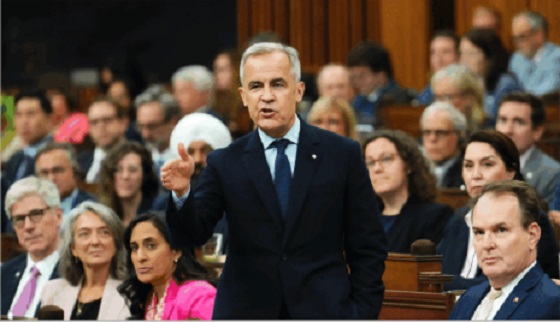Automotive
Ottawa’s EV mandate may destroy Canadian auto industry

From the Fraser Institute
No one had to force the public to abandon land lines for cellphones, or vinyl records for CDs and then online streaming. When superior products appear, people will switch voluntarily. An EV mandate may be affordable by 2035—but only if the product quality and user costs have progressed to the point that people want to switch anyway, in which case the mandate is not needed.
According to energy transition and “net zero” enthusiasts, the future looks bright for electric vehicles (EVs). So bright that the federal government and some provincial governments have had to offer some $15 billion in subsidies to prompt carmakers to develop Canadian production facilities while also offering lavish subsidies to get people to buy EVs. And since even that isn’t enough, according to a Trudeau government mandate, all new light-duty vehicles sold in Canada must be electric or plug-in hybrid by 2035. In other words, the government wants to ban traditional internal combustion engine vehicles (ICEVs).
The fundamental problem is that EVs cost more to make and operate than most consumers are willing to pay. In a 2016 submission to the Quebec government, which was then considering an EV mandate of its own, the Canadian Vehicle Manufacturing Association warned that its members were then losing between $12,000 and $20,000 per EV sold. Since then, the situation has gotten worse, with Ford reporting first quarter 2024 losses of US$132,000 per EV.
What will be the economic consequences of a national EV mandate in Canada? In a new paper forthcoming in the peer-reviewed Canadian Journal of Economics, I develop and run a detailed inter-provincial model of the Canadian economy including the auto sector. I argue that during the phase-in period the auto sector will raise the price of ICEVs and earn above-market rents on them, but that won’t cover the losses on the EV side and the industry will go into overall losses by the late-2020s. The losses will be permanent unless and until EV production costs fall enough that a mandate is unnecessary. In short, the 2035 mandate is affordable only if it’s not needed. If it takes a mandate to force consumers to choose EVs over ICEVs, the mandate will destroy the Canadian auto industry.
The mandate sets up a race between regulation and technology. Some aspects of EV production are falling, such as batteries. Others, such as specialty metals used in motors, are sole-sourced from China and are not getting cheaper. Other user costs are rising including electricity, for which we can thank two decades of green energy madness. Taking all aspects together, suppose EV technology improves so quickly that by 2035 consumers are absolutely indifferent between an EV and an ICEV, so the mandate is costless thereafter. Getting to that point would still impose Canadian auto industry losses that total $140 billion compared to the no-policy base case. As of 2031 the losses in real GDP and industrial output compared to the base case would average more than $1,000 per worker across Canada. Greenhouse gas emissions would fall by just under 3 per cent relative to the base case as of 2035, but the abatement costs reach about $2,800 per tonne as of 2030.
That’s the best-case scenario. What if full EV cost parity takes until 2050? According to the model, the auto sector will lose $1.3 trillion relative to the base case between 2025 and 2050. Of course, in reality the sector would simply shut down, but in the model a sector must keep operating even at a loss. In absolute terms the national economy would continue to grow but much more slowly. Economic losses relative to the base case as of 2035 include a 4.8 per cent reduction in real GDP nationally (8.9 per cent in Ontario), a 2.6 per cent cut in real earnings per worker, 137,000 jobs lost, a 10.5 per cent drop in auto demand nationally and a 16.8 per cent drop in capital earnings relative to average. Greenhouse gas emissions would fall by just under 6 per cent against the base case as of 2035 but at a cost of more than $3,400 per tonne, 20 times the nominal carbon tax rate.
These are unprecedented costs, but then again we have never before proposed to ban the production and purchase of one of the most popular consumer products of all time. A large part of our economy is organized around making and using gasoline-powered cars, so if the government plans to outlaw them we should not be surprised that doing so will have harsh and far-reaching economic consequences. While production of EVs will partially offset the losses, it’s a classic error in economic reasoning to suppose the policy package as a whole could yield a net gain or offer a genuine economic opportunity. If it could, think of all the economic growth we could contrive simply by banning things. We could ban computers and make people read books instead—think of the boom in publishing. We could ban all forms of transportation and make people walk. Think of how much money they’d save, and the opportunities this would open up for shoemakers.
I better stop there before I put ideas in politicians’ heads. To be clear, people are willing to pay for computers, cars and lots of other things because they perceive that they get greater consumption value than the cost of buying the item. So far that has not proven to be true of EVs, so an EV mandate by definition must make people worse off. No one had to force the public to abandon land lines for cellphones, or vinyl records for CDs and then online streaming. When superior products appear, people will switch voluntarily. An EV mandate may be affordable by 2035—but only if the product quality and user costs have progressed to the point that people want to switch anyway, in which case the mandate is not needed.
Will an EV mandate destroy the Canadian auto industry and impose serious harm on the Canadian economy? There’s a simple way to tell: if the government perceives, based on trends in vehicle sales data, that a mandate is necessary to force consumers to switch, the answer is yes.
Author:
Automotive
America’s EV Industry Must Now Compete On A Level Playing Field


From the Daily Caller News Foundation
America’s carmakers face an uncertain future in the wake of President Donald Trump’s signing of the One Big Beautiful Bill Act (OBBBA) into law on July 4.
The new law ends the $7,500 credit for new electric vehicles ($4,000 for used units) which was enacted as part of the 2022 Inflation Reduction Act as of September 30, seven years earlier than originally planned.
The promise of that big credit lasting for a full decade did not just improve finances for Tesla and other pure-play EV companies: It also served as a major motivator for integrated carmakers like Ford, GM, and Stellantis to invest billions of dollars in capital into new, EV-specific plants, equipment, and supply chains, and expand their EV model offerings. But now, with the big subsidy about to expire, the question becomes whether the U.S. EV business can survive in an unsubsidized market? Carmakers across the EV spectrum are about to find out, and the outlook for most will not be rosy.
These carmakers will be entering into a brave new world in which the market for their cars had already turned somewhat sour even with the subsidies in place. Sales of EVs stalled during the fourth quarter of 2024 and then collapsed by more than 18% from December to January. Tesla, already negatively impacted by founder and CEO Elon Musk’s increased political activities in addition to the stagnant market, decided to slash prices in an attempt to maintain sales momentum, forcing its competitors to follow suit.
But the record number of EV-specific incentives now being offered by U.S. dealers has done little to halt the drop in sales, as the Wall Street Journal reports that the most recent data shows EV sales falling in each of the three months from April through June. Ford said its own sales had fallen by more than 30% across those three months, with Hyundai and Kia also reporting big drops. GM was the big winner in the second quarter, overtaking Ford and moving into 2nd place behind Tesla in total sales. But its ability to continue such growth absent the big subsidy edge over traditional ICE cars now falls into doubt.
The removal of the per-unit subsidies also calls into question whether the buildout of new public charging infrastructure, which has accelerated dramatically in the past three years, will continue as the market moves into a time of uncertainty. Recognizing that consumer concern, Ford, Hyundai, BMW and others included free home charging kits as part of their current suites of incentives. But of course, that only works if the buyer owns a home with a garage and is willing to pay the higher cost of insurance that now often comes with parking an EV inside.
Decisions, decisions.
As the year dawned, few really expected the narrow Republican congressional majorities would show the political will and unity to move so aggressively to cancel the big IRA EV subsidies. But, as awareness rose in Congress about the true magnitude of the budgetary cost of those provisions over the next 10 years, the benefit of getting rid of them ultimately subsumed concerns about the possible political cost of doing so.
So now, here we are, with an EV industry that seems largely unprepared to survive in a market with a levelized playing field. Even Tesla, which remains far and away the leader in total EV sales despite its recent struggles, seems caught more than a little off-guard despite Musk’s having been heavily involved in the early months of the second Trump presidency.
Musk’s response to his disapproval of the OBBBA was to announce the creation of a third political party he dubbed the American Party. It seems doubtful this new vanity project was the response to a looming challenge that members of Tesla’s board of directors would have preferred. But it does seem appropriately emblematic of an industry that is undeniably limping into uncharted territory with no clear plan for how to escape from existential danger.
We do live in interesting times.
David Blackmon is an energy writer and consultant based in Texas. He spent 40 years in the oil and gas business, where he specialized in public policy and communications.
Automotive
Federal government should swiftly axe foolish EV mandate

From the Fraser Institute
Two recent events exemplify the fundamental irrationality that is Canada’s electric vehicle (EV) policy.
First, the Carney government re-committed to Justin Trudeau’s EV transition mandate that by 2035 all (that’s 100 per cent) of new car sales in Canada consist of “zero emission vehicles” including battery EVs, plug-in hybrid EVs and fuel-cell powered vehicles (which are virtually non-existent in today’s market). This policy has been a foolish idea since inception. The mass of car-buyers in Canada showed little desire to buy them in 2022, when the government announced the plan, and they still don’t want them.
Second, President Trump’s “Big Beautiful” budget bill has slashed taxpayer subsidies for buying new and used EVs, ended federal support for EV charging stations, and limited the ability of states to use fuel standards to force EVs onto the sales lot. Of course, Canada should not craft policy to simply match U.S. policy, but in light of policy changes south of the border Canadian policymakers would be wise to give their own EV policies a rethink.
And in this case, a rethink—that is, scrapping Ottawa’s mandate—would only benefit most Canadians. Indeed, most Canadians disapprove of the mandate; most do not want to buy EVs; most can’t afford to buy EVs (which are more expensive than traditional internal combustion vehicles and more expensive to insure and repair); and if they do manage to swing the cost of an EV, most will likely find it difficult to find public charging stations.
Also, consider this. Globally, the mining sector likely lacks the ability to keep up with the supply of metals needed to produce EVs and satisfy government mandates like we have in Canada, potentially further driving up production costs and ultimately sticker prices.
Finally, if you’re worried about losing the climate and environmental benefits of an EV transition, you should, well, not worry that much. The benefits of vehicle electrification for climate/environmental risk reduction have been oversold. In some circumstances EVs can help reduce GHG emissions—in others, they can make them worse. It depends on the fuel used to generate electricity used to charge them. And EVs have environmental negatives of their own—their fancy tires cause a lot of fine particulate pollution, one of the more harmful types of air pollution that can affect our health. And when they burst into flames (which they do with disturbing regularity) they spew toxic metals and plastics into the air with abandon.
So, to sum up in point form. Prime Minister Carney’s government has re-upped its commitment to the Trudeau-era 2035 EV mandate even while Canadians have shown for years that most don’t want to buy them. EVs don’t provide meaningful environmental benefits. They represent the worst of public policy (picking winning or losing technologies in mass markets). They are unjust (tax-robbing people who can’t afford them to subsidize those who can). And taxpayer-funded “investments” in EVs and EV-battery technology will likely be wasted in light of the diminishing U.S. market for Canadian EV tech.
If ever there was a policy so justifiably axed on its failed merits, it’s Ottawa’s EV mandate. Hopefully, the pragmatists we’ve heard much about since Carney’s election victory will acknowledge EV reality.
-

 Business1 day ago
Business1 day agoMark Carney’s Fiscal Fantasy Will Bankrupt Canada
-

 Opinion1 day ago
Opinion1 day agoCharity Campaigns vs. Charity Donations
-

 Alberta1 day ago
Alberta1 day agoTemporary Alberta grid limit unlikely to dampen data centre investment, analyst says
-

 Frontier Centre for Public Policy2 days ago
Frontier Centre for Public Policy2 days agoCanada’s New Border Bill Spies On You, Not The Bad Guys
-

 Daily Caller20 hours ago
Daily Caller20 hours ago‘Strange Confluence Of Variables’: Mike Benz Wants Transparency Task Force To Investigate What Happened in Butler, PA
-

 Uncategorized2 days ago
Uncategorized2 days agoCNN’s Shock Climate Polling Data Reinforces Trump’s Energy Agenda
-

 Opinion1 day ago
Opinion1 day agoPreston Manning: Three Wise Men from the East, Again
-

 COVID-191 day ago
COVID-191 day agoTrump DOJ dismisses charges against doctor who issued fake COVID passports




